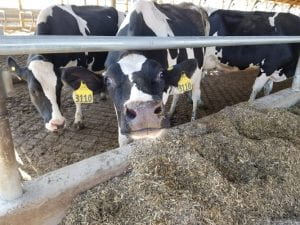By Betsy Hicks & Christine Georgakakos
Disease Prevention
Many dairy farmers know the truth in the saying, “an ounce of prevention is worth a pound of cure”, and manage their herds in such a way as to keep their cows healthy rather than having to treat sick cows. Not only does disease prevention keep herds healthy, it also minimizes antibiotic usage. Farmers we interviewed discussed three main ways of keeping their herds healthy as related to reduction in antibiotic usage: vaccination & immunity, cow comfort & facility conditions, and attention to nutrition at every stage of life. Our interviews with dairy producers highlighted similarities in terms of disease prevention, no matter farm size or management system.
Vaccinations & Immunity
Farmers in every management system we interviewed discussed vaccination as a powerful tool for disease prevention. One organic producer stated, “we try to find, do everything possibly under the sun, to prevent … that’s the key, how to prevent all these issues”. Similarly, a large conventional farmer noted that intensive, farm-specific vaccination protocols were key to using less antibiotics, stating, “When we were 100 cow farm, we would probably treat more cows with [antibiotics] than we ever do now. It was, in years past, it was a more reactive thing. Cows are sick, now the bigger your farm gets, you tend to be more … proactive … so you tend to worry about your vaccines, and making sure they’re all in line”.
Newborn calf immunity was also seen as a major avenue to prevent disease & minimize antibiotic usage. Colostrum feeding to newborns was discussed among all farm categories. One conventional farmer explained: “A baby is going to get her first couple months of immunity from that colostrum. If you collect it right and you give it to them in a timely fashion, and you give them enough … they’re going to get their immunities from there because you can’t really vaccinate a calf and have their immune system ready to respond to that vaccine until three/four months of age.”
Cow Comfort & Facility Conditions
Another unifying theme we found among farmers was the belief and practice of using cow comfort to maintain good animal health – whether it be through barn design, flooring material, or minimizing stress. One farmer in our study said: “Give them the best you can give them to eat and keep them comfortable with good air”. Baby Boomers especially commented on minimizing stress as an important factor, and one farmer commented that, “you know, it’s kind of like people. You hear about people getting sick and their doctor says, ‘You need to quit your job. There’s too much stress.’ And then they just start feeling better. Well I think it’s the same with cows. When you’re not pushing them for production”. One Gen X farmer talked about minimizing stress: “we just like them to be cows. I hate doing anything to them that I don’t have to do”. Analyzing and improving facility conditions in terms of cow comfort was mentioned among all categories of farmers. Some farmers stated, “if we have a lot of mastitis issues … is everything clean? Is there an issue in the equipment? And then in the barn where the cows lay in the stalls, liming the stalls, keeping everything nice and clean and dry”. Ventilation and keeping the cows’ environment clean were a main focus for many of our conversations around disease prevention.
Nutrition
Fresh cow nutrition and care was frequently referenced by farmers to help prevent disease on their dairies. Across categories, farmer noted that this stage required more attention, with an increased need for treatments (both antibiotic and non-antibiotic) as compared to the rest of lactation. Treatments referenced across management scales included calcium bolus, drenching and giving vitamin supplementation. Conventional farmers were more likely to mention these practices as an alternative to antibiotics than organic farmers. Probiotics were also widely references as being a supplement for fresh cows across management.
Calf care also appeared to be a top priority for farmers across all farm categories. “The calf stuff has been a really big deal in terms of preventative stuff, and in terms of treatment” was a common perception we heard. Improving calf immunity through colostrum, vaccination and probiotics was often discussed. One farmer stated, “Every calf gets colostrum. If it’s born at 11 o’clock at night, I stay up with that damn calf, and it gets colostrum,” highlighting the importance farmers put on making sure calves get the care they need.
The Dairy Industry Unified
Ways to achieve herd health may differ among farms, but there are many common themes across the industry on how farmers view disease prevention. Noting these commonalities is a way to share to the public that the industry is working towards healthier herds and less antibiotic usage every day. These disease prevention actions and others ultimately lead to reduced antibiotic usage on farms and reduced risk of antibiotic residues and resistant bacteria in the environment.

